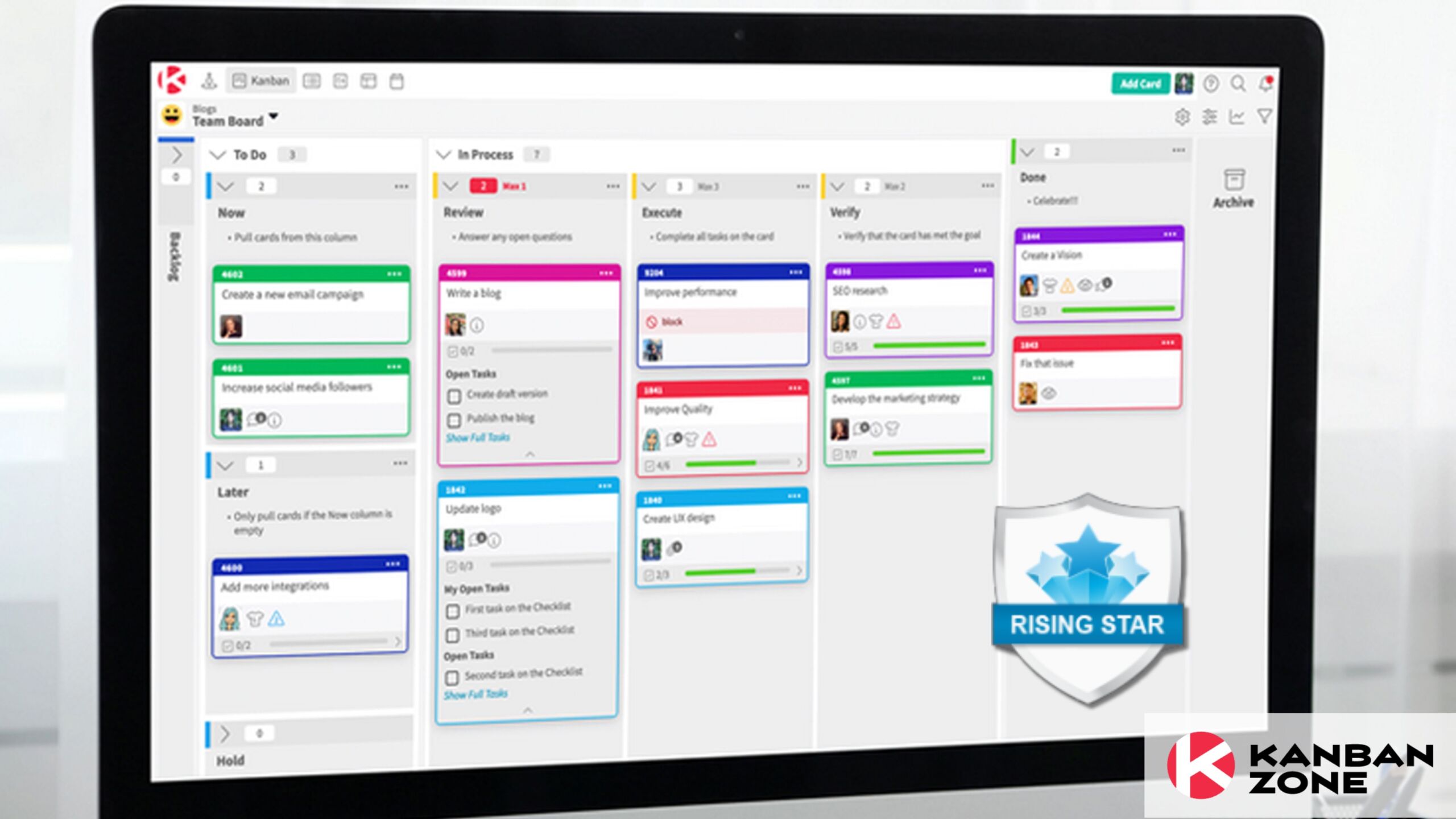
Every business, whether a nimble startup or a sprawling corporate giant, has its set of metaphorical cogs and wheels that keep it chugging along. But, these systems are not immune to hitches. At times, inefficiencies act as the proverbial wrench in the gears, gumming up processes, wasting precious resources, and stalling progress.
And in today’s rapidly evolving business landscape, with rising costs, demand for sustainability, and fierce competition, these inefficiencies are more of a liability than ever before. It isn’t merely about ticking boxes or meeting quotas; it’s about sculpting a business environment that thrives on efficiency and prudent resource management.
Enter Kanban, a system rooted in the principles of Lean Thinking and a strategy that has been adopted by a multitude of industries around the globe. While many associate Kanban with simple visual boards that track work in progress, its depth and potential to revolutionize business processes go much further.
This article will explore how Kanban facilitates effective resource utilization and waste reduction, providing your organization with the tools to sculpt an ecosystem of streamlined operations and flourishing efficiency.
The Interplay of Kanban and Lean Thinking
Understanding Kanban begins with recognizing its deep ties to Lean Thinking.
Born out of the Japanese manufacturing sector, Lean Thinking is a philosophy that focuses on delivering maximum value while eliminating non-value-adding activities and processes. This ethos challenges organizations to scrutinize their workflows, exposing the sources of inefficiency and optimizing operations for unparalleled productivity.
Kanban, a Japanese term translating to “signboard,” was originally conceived as a scheduling system for lean production. In essence, Kanban acts as a conduit for Lean Thinking, translating its high-level principles into ground-level strategies.
Pull System and Just-in-time (JIT) Production
In contrast to traditional “push” systems, which rely on forecasts to determine the amount of a product or service needed, a pull system, as endorsed by Lean and embodied by Kanban, operates in response to actual demand. This JIT approach minimizes idle time, stockpiles, and the potential waste of overproduction, reinforcing resource efficiency and waste reduction.
Visualizing Work and Workflow
Kanban boards, whether digital or physical, give teams a clear visual representation of tasks, from the progress of individual tasks to team-wide objectives. This immediate visual feedback serves as a mirror, reflecting the realities of an operation or a project’s workflow. This way, teams can identify bottlenecks, overburdened resources, and other hitches in real-time, enabling prompt intervention and adjustment.
Limiting Work In Progress (WIP)
By capping the number of tasks a team can work on at any given time, Kanban keeps teams from multitasking and overloading their capacity. This keeps the workflow from getting too backed up and ensures that tasks only advance to the subsequent phase when the capacity for it becomes available.
Continuous Improvement
Both Lean Thinking and Kanban champion the spirit of ‘Kaizen’ – a dedication to continuous improvement. The goal isn’t to enact large, sweeping changes but to focus on small, incremental improvements that, when aggregated, result in transformative advancements. In a Kanban setting, this concept materializes through regular review sessions and feedback loops. And as inefficiencies surface, solutions are devised, tested, and implemented. Over time, these consistent efforts lead to dramatic improvements in operational efficiency and a noticeable reduction in resource wastage.
Harnessing the Power of Kanban Across Industries
The versatility and adaptability of Kanban make it applicable to a wide variety of industries, from software development to healthcare. While the core tenets of Kanban remain consistent, its implementation can vary, molding itself to each sector’s unique challenges and dynamics.
Manufacturing Plants
In manufacturing, wastes are often tangible, directly affecting the bottom line. Overproduction, waiting times, and excessive inventory are some classic examples. Here, Kanban streamlines production schedules and inventory management. By synchronizing demand with production capacity, Kanban ensures that resources are allocated effectively, reducing the need for storage space and lowering the chances of obsolete stock.
Digital and Creative Agencies
In the world of creative agencies, where tasks and projects often oscillate between spurts of inspiration and stretches of contemplation, wastes manifest in the form of scope creeps, undelivered projects, miscommunication, and unoptimized resource planning. Agencies require a dynamic and structured approach to navigate client projects’ unpredictable ebb and flow. Kanban facilitates this balance by offering a framework that melds adaptability with methodical planning. Its visual boards assist teams in monitoring project timelines, assigning resources judiciously, and ensuring all stakeholders have a clear, real-time understanding of progress and potential hurdles.
Healthcare Facilities
At first glance, healthcare might seem an unlikely candidate for Kanban’s applicability. Yet the challenges these facilities face – be it patient scheduling, equipment utilization, or medication management – all echo the universal themes of resource optimization and waste reduction. The only difference lies in the stakes involved; inefficiencies in healthcare can quite literally be a matter of life and death. Kanban can help healthcare providers weave the disparate admin threads into a cohesive fabric of improved patient care, increased safety, reduced wait times, and optimized resource utilization.
Tool to Elevate Your Kanban Experience
The rudimentary Kanban board, with its columns and sticky notes, has evolved dramatically with the advent of technology. Today, a slew of digital tools are available to further enhance and customize the Kanban experience. By integrating these tools into your workflow, organizations can derive even greater waste reduction and resource optimization outcomes from the Kanban system:
Visual Collaboration Platform
Visual collaboration platforms like Kanban Zone take the traditional Kanban board a step further, morphing it into an interactive workspace. These platforms enable real-time collaboration, allowing team members to comment, edit, annotate, and chalk out strategies directly on the board.
This interactivity bridges communication gaps, enhancing the clarity and coherence of work processes. As a result, there will be reduced redundancy in communication, fewer status meetings, and more fluid decision-making processes. By ensuring everyone remains on the same page and can access crucial information promptly, these platforms can lead to significant time and resource savings.

QR Codes
Incorporating QR codes into your Kanban system can help streamline access and authentication processes. These codes can be scanned to grant team members access to digital boards, specific task details, or even to update the status of a task.
By only allowing authorized personnel to make changes or access sensitive information, organizations can significantly reduce errors, miscommunications, and unauthorized alterations. This saves time and mitigates the needless expense associated with rectifying mistakes. Just make sure to choose a reliable and secure QR code generator to maintain the integrity of your system.
No-code Automation Tools
The age of automation has arrived, and with it, the opportunity to further enhance Kanban systems. No-code automation tools, accessible even to those without a background in coding, can integrate with Kanban boards to trigger automated processes.
For instance, once a task moves to the ‘Completed’ column, an automation tool can automatically send notifications to relevant stakeholders, update inventory databases, or even initialize the next stage in a project. Such integrations reduce manual overhead, eliminating the potential for human-induced wastage and errors.
Path to Sustainable Success with Kanban
Kanban, when deeply understood and effectively implemented, is more than just a tool—it’s a mindset. It encapsulates the essence of Lean Thinking, championing optimal resource utilization, waste reduction, and a relentless pursuit of efficiency. As businesses strive to navigate the complexities of today’s economic landscape, the adoption of Kanban might just be the beacon they need, illuminating the path to sustainable success.
This was a guest blog. Please review our guest blog disclaimer.
Learn to Work Smarter, Not Harder!
Get our top articles weekly.
Table Of Contents
Discover many more posts…







